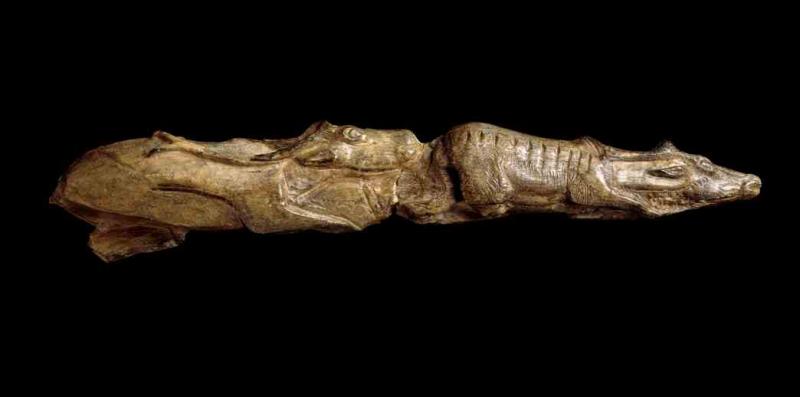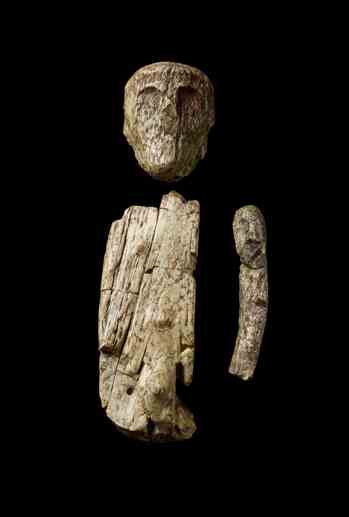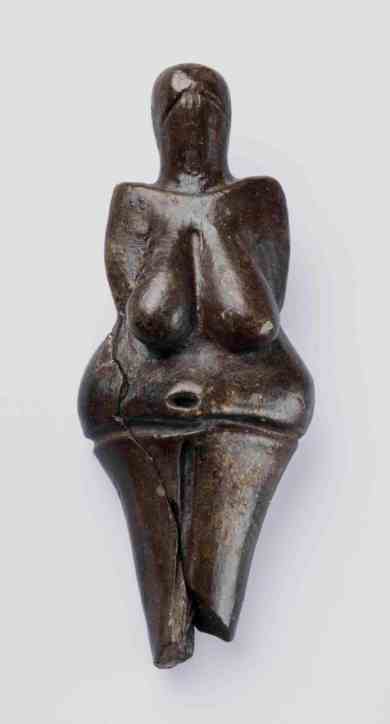Ice Age Art: Arrival of the Modern Mind, British Museum | reviews, news & interviews
Ice Age Art: Arrival of the Modern Mind, British Museum
Ice Age Art: Arrival of the Modern Mind, British Museum
Unmissable collection of fragments finds art at the heart of prehistoric life

Prehistory – human life before written language - enters art’s mainstream with this seminal and eye-opening exhibition. This one-off show, amplified by excellent labelling and atmospheric lighting, is enormously ambitious: the largest anthology of portable prehistoric European art there has ever been, unprecedented in its scope with artefacts from museums in Russia, Germany, France, and the Czech Republic, homes to the greatest of the sites.
On show are the oldest known representations of animals and people, free-standing sculptures - some tiny, others easily held in the hand, a few slightly more substantial; engravings on stone, carvings, some in swirling patterns, to decorate tools and weapons, and flutes made from bird bones and ivory.
 The Ice Age cave paintings of France and Spain are now shut to tourists, and their substantial sculptures and friezes cannot be moved, so this is probably the best chance actually to see some of the most important, significant and beautiful examples of the oldest European art. What is on view has travelled through time but now hardly ever travels on loan: ancient bone, mammoth ivory, wood, clay is immensely brittle and therefore immensely fragile. (Pictured right: The oldest puppet or doll, made of mammoth ivory. On loan from Moravian Museum, Anthropos Institute.)
The Ice Age cave paintings of France and Spain are now shut to tourists, and their substantial sculptures and friezes cannot be moved, so this is probably the best chance actually to see some of the most important, significant and beautiful examples of the oldest European art. What is on view has travelled through time but now hardly ever travels on loan: ancient bone, mammoth ivory, wood, clay is immensely brittle and therefore immensely fragile. (Pictured right: The oldest puppet or doll, made of mammoth ivory. On loan from Moravian Museum, Anthropos Institute.)
The thesis of this examination of art of the ice age in Europe – an awesome 20,000 to 40,000 years ago – is that it was human minds physiologically like ours today which both observed and conceptualised the world around them, captured the look of living creatures and by artistic exaggeration and stylisation, created an emotional impact.
Art is also evidence, and it is the material culture that remains
This is an exhibition that decisively indicates the centrality of art to human life. We know very little about the beliefs and social structures of these early human groups, who had migrated to Europe out of Africa. We have their burial sites, their skeletons, and we know something of their environment: the vast icy plains, the shelters in caves and under cliffs and overhangs. But art is also evidence, and it is the material culture that remains. And these small groups of hunter gatherers must have valued it. Contemporary scholars have, by imitating the techniques involved and recreating the tools, estimated the large number of hours involved in the creation of individual objects. The makers, they conclude, must have been supported by their peers, their labour seen as essential, not superfluous.
We mostly do not know for whom – shamans, say, or tribal leaders – or what rituals the objects under scrutiny were used for; but even a remnant of a hunting weapon, utilitarian as it was, could be decorated. So the anthology is in part a three-dimensional detective story with no definitive answers.
 Scholars can only speculate about the tantalising and amazing array of fat female torsos, small in size, monumental in effect. How enormous these mothers are, how brilliantly modelled, even imagined: it is difficult to imagine any inhabitants of the Ice Age having in reality an ounce of superfluous flesh. But the carved women – some of them pregnant - have vast pendulous breasts, great bellies, and huge backsides: were they fertility symbols, talismans, homages, made for good fortune by women for women, or by men? The bodies are powerful, imposing, even overwhelming.(Pictured left, the oldest ceramic figure in the world: modelled figure of a mature woman from Dolni Vestonice. On loan from Moravske Zemske Museum. Brno)
Scholars can only speculate about the tantalising and amazing array of fat female torsos, small in size, monumental in effect. How enormous these mothers are, how brilliantly modelled, even imagined: it is difficult to imagine any inhabitants of the Ice Age having in reality an ounce of superfluous flesh. But the carved women – some of them pregnant - have vast pendulous breasts, great bellies, and huge backsides: were they fertility symbols, talismans, homages, made for good fortune by women for women, or by men? The bodies are powerful, imposing, even overwhelming.(Pictured left, the oldest ceramic figure in the world: modelled figure of a mature woman from Dolni Vestonice. On loan from Moravske Zemske Museum. Brno)
The oldest holding in the British Museum is The Swimming Reindeer, discovered in France in the 1860s, some 13,000 years old and showing a male and female in the posture adopted by the animals when swimming, and carved from a mammoth tusk with a full understanding of its shape and properties. Each object, be it a flying bird, leaping lion, mating deer, bison, mammoth, wild horse – conveys deep respect for these creatures and a feeling for the way they moved. Human survival depended on them.
The compound impact of these fragments is curiously affecting. The point is brilliantly made that although we can have hardly any glimpse of the reality of these far-off lives, there is a continuum to human concerns: how humans navigated their world, and how thousands of years ago modern man began to express that in art.
So-called primitive art from prehistoric to tribal had been seized on by the avant garde of the early 20th century. So the British Museum amplifies Ice Age Art with a Mondrian drawing of trees, a Henry Moore sculpture, a photograph of Picasso in his studio with his collection, and Matisse drawings. The idea that the objects of prehistory have much to show us has been gestating for quite a while, and here reaches an apotheosis in this unmissable display.
Click on the images to enlarge
Explore topics
Share this article
The future of Arts Journalism
You can stop theartsdesk.com closing!
We urgently need financing to survive. Our fundraising drive has thus far raised £49,000 but we need to reach £100,000 or we will be forced to close. Please contribute here: https://gofund.me/c3f6033d
And if you can forward this information to anyone who might assist, we’d be grateful.

Subscribe to theartsdesk.com
Thank you for continuing to read our work on theartsdesk.com. For unlimited access to every article in its entirety, including our archive of more than 15,000 pieces, we're asking for £5 per month or £40 per year. We feel it's a very good deal, and hope you do too.
To take a subscription now simply click here.
And if you're looking for that extra gift for a friend or family member, why not treat them to a theartsdesk.com gift subscription?
more Visual arts
 'We are bowled over!' Thank you for your messages of love and support
Much-appreciated words of commendation from readers and the cultural community
'We are bowled over!' Thank you for your messages of love and support
Much-appreciated words of commendation from readers and the cultural community
![SEX MONEY RACE RELIGION [2016] by Gilbert and George. Installation shot of Gilbert & George 21ST CENTURY PICTURES Hayward Gallery](https://theartsdesk.com/sites/default/files/styles/thumbnail/public/mastimages/Gilbert%20%26%20George_%2021ST%20CENTURY%20PICTURES.%20SEX%20MONEY%20RACE%20RELIGION%20%5B2016%5D.%20Photo_%20Mark%20Blower.%20Courtesy%20of%20the%20Gilbert%20%26%20George%20and%20the%20Hayward%20Gallery._0.jpg?itok=7tVsLyR-) Gilbert & George, 21st Century Pictures, Hayward Gallery review - brash, bright and not so beautiful
The couple's coloured photomontages shout louder than ever, causing sensory overload
Gilbert & George, 21st Century Pictures, Hayward Gallery review - brash, bright and not so beautiful
The couple's coloured photomontages shout louder than ever, causing sensory overload
 Lee Miller, Tate Britain review - an extraordinary career that remains an enigma
Fashion photographer, artist or war reporter; will the real Lee Miller please step forward?
Lee Miller, Tate Britain review - an extraordinary career that remains an enigma
Fashion photographer, artist or war reporter; will the real Lee Miller please step forward?
 Kerry James Marshall: The Histories, Royal Academy review - a triumphant celebration of blackness
Room after room of glorious paintings
Kerry James Marshall: The Histories, Royal Academy review - a triumphant celebration of blackness
Room after room of glorious paintings
 Folkestone Triennial 2025 - landscape, seascape, art lovers' escape
Locally rooted festival brings home many but not all global concerns
Folkestone Triennial 2025 - landscape, seascape, art lovers' escape
Locally rooted festival brings home many but not all global concerns
 Sir Brian Clarke (1953-2025) - a personal tribute
Remembering an artist with a gift for the transcendent
Sir Brian Clarke (1953-2025) - a personal tribute
Remembering an artist with a gift for the transcendent
 Emily Kam Kngwarray, Tate Modern review - glimpses of another world
Pictures that are an affirmation of belonging
Emily Kam Kngwarray, Tate Modern review - glimpses of another world
Pictures that are an affirmation of belonging
 Kiefer / Van Gogh, Royal Academy review - a pairing of opposites
Small scale intensity meets large scale melodrama
Kiefer / Van Gogh, Royal Academy review - a pairing of opposites
Small scale intensity meets large scale melodrama
 Jenny Saville: The Anatomy of Painting, National Portrait Gallery review - a protégé losing her way
A brilliant painter in search of a worthwhile subject
Jenny Saville: The Anatomy of Painting, National Portrait Gallery review - a protégé losing her way
A brilliant painter in search of a worthwhile subject
 Abstract Erotic, Courtauld Gallery review - sculpture that is sensuous, funny and subversive
Testing the boundaries of good taste, and winning
Abstract Erotic, Courtauld Gallery review - sculpture that is sensuous, funny and subversive
Testing the boundaries of good taste, and winning
 Edward Burra, Tate Britain review - watercolour made mainstream
Social satire with a nasty bite
Edward Burra, Tate Britain review - watercolour made mainstream
Social satire with a nasty bite
 Ithell Colquhoun, Tate Britain review - revelations of a weird and wonderful world
Emanations from the unconscious
Ithell Colquhoun, Tate Britain review - revelations of a weird and wonderful world
Emanations from the unconscious



Add comment